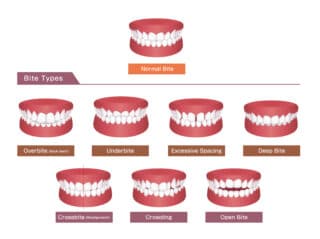
More Dental Health Articles
Why a Bad Bite Could Be Causing Your Dental Problems

As we age, it is completely normal for our tooth enamel to slowly wear down. For example, at the age of 30 a “normal adult” will have lost about a millimeter of their front teeth. This is due to the improper chewing. Recently, studies have shown an increasing number of adults experiencing excessive wear and chipping, beyond the normal, which has led an increasing need for root canals and/or extractions due to an imbalanced bite. This not only affects us negatively, but can also be prevented by correcting a “bad bite.”
Why Incorrect Bites Are a Problem
Incorrect bite, also known as malocclusion, can be caused by a variety of things. The most common cause comes from childhood habits, such as thumb sucking. The mechanism of thumb sucking causes improper forces to act on the growing and developing teeth. Thus, leading to wrong placement and alignment of the teeth. The term “bad bite” is an overarching term since it describes how the top and bottom align together. Here are some examples of bad bites:
- Protrusive incisors or overbite: occurs when the upper teeth extend too far forward, protruding past the front lower teeth. Overbite can be caused by a number of different things, commonly thumb sucking, nail biting, lip biting, misaligned jaws, or even heredity. Overbite inhibits proper chewing and increases the chance for chipping and/or fracturing during trauma.
- Prognathism or underbite: when the lower teeth extend too far forward. The causes and effects are the same as an overbite. Ultimately causes excessive wear on the enamel.
- Retrusive incisors or inward slanting of the teeth: common causes are when the teeth erupt at an angle, crowding, accidental, and tooth disorders. The condition not only affects chewing ability but as well as limiting proper range of motion of the lower jaw. The lower front teeth will often collide with the upper, increasing the change for chips, breaks, and/or fractures.
- Edge-to-edge bites: occurs when the biting edges of the upper teeth bite directly onto the lower front teeth. The chewing process between the incisors is impacted and can lead to chipping of the front teeth.
As you can see, all four examples of bad bites lead to chipping, fracturing, and wearing on the tooth, which can be a whole problem itself since bacteria can now easily infect the roots and nerves of the tooth. Drinking or chewing anything hot or cold can cause extreme pain when the most sensitive part of the tooth is exposed. In addition to chipping and fracturing, a bad bite can also increase tooth sensitivity, jaw pain, and headaches. Yes, dental bonding and crowns can patch up the tooth but it’s not a permanent solution that’ll last forever.
Fixing a Bad Bite
It is best to address the underlying cause by providing a permanent solution that’ll last forever. A variety treatments are available that can correct a bad bite. Some of these treatments include plate expansion (oral appliance), Invisalign, and traditional braces.
Other Articles You May Find of Interest...
- Let’s Smile Dental’s 7&Up Club
- Strengthening Smiles: Understanding the Importance of Splinting Periodontally Involved Teeth
- Understanding Soft Tissue Grafting: A Key To Periodontal Health
- New Solutions for Dentures and Dental Implants
- Cerec Dental Technology
- Commonly Treated Orthodontic Problems
- Can You Benefit From Braces?

















